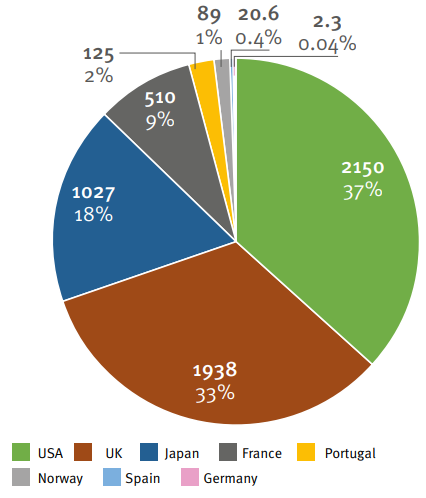Spanish group to start building ‘disruptive’ floating demo
Saitec's pivotable concrete design brings further innovations to the growing range of floating wind technologies that are attracting commercial interest.

Related Articles
Next month, Spain's Saitec Offshore Technologies will begin construction of DemoSATH, the first floating wind turbine to be connected to Spain's power grid.
Backed by German energy group RWE, the 2 MW project will be installed two miles off the Basque coast in northern Spain. The partners reached the final investment decision (FID) on the project earlier this year.
Floating wind groups are developing a wide range of technologies and using pilot projects to attract commercial partners. Designs which have been deployed early include Equinor's spar buoy concept and Principle Power's semi-submersible platform, but many other technologies are attracting interest.
Saitec believes its floating wind design could be "disruptive" for the floating wind market, David Carrascosa, Chief Technology Officer at Saitec Offshore Technologies, told the conference on October 2.
The floating structure is made entirely from concrete and features twin hulls and a single point of connection for the mooring system.
The use of concrete rather than steel reduces manufacturing costs and also promotes the use of domestic companies, key to meeting local content rules set in many offshore tenders, Carrascosa said.
Based on concepts used in the oil and gas industry, the single-point mooring system allows the platform to rotate like a weathervane facing into the wind.
This optimises wind resources and "dramatically" simplifies the connection process, reducing the amount of time required at sea, he said.
Data pooling
In August, Saitec commissioned its BlueSATH pilot project in waters near Santander, northern Spain. The project will operate for 12 months and learnings will be used to de-risk the DemoSATH project.
Installed floating wind capacity by country (in early planning phase)

Source: 'Offshore wind, ready to float?' report by University of Strathclyde, DNV GL (2019)
Built at 1/6 scale, BlueSATH features a 30kW turbine of rotor diameter 15 metres and hub height 17.5 m. The turbine is secured to the sea bed via three 150m steel catenary chain mooring lines and drag anchors.
The scaling down of design dimensions required certain changes to the relative dimensions and materials for testing purposes. Saitec selected a site near Santander as the local bay provides some protection from north-westerly storms, resulting in scaled down storm behaviour.
Saitec worked with local Spanish companies to develop real-time performance monitoring tools, Carrascosa said.
The single-point mooring line system will be a key focus area of the performance monitoring, both in terms of turbine operation and component reliability, he said.
Deeper insights
For DemoSATH, Saitec will move up in scale and install a 2 MW turbine in water depths of 85 MW. The turbine will have a rotor diameter of 80 m and hub height of 66 m. Six mooring lines made of catenary steel chain and polyester fibre will be anchored to the seabed and connected to the structure at a single point. Floating wind developers are shifting away from conventional steel catenary lines, favoring synthetic fibres that reduce costs and improve reliability.
RWE is financing part of the project costs and supplying offshore expertise.
The project will test operations and maintenance (O&M) efficiency, as well as turbine performance, RWE said in a statement earlier this year. O&M is a key consideration when operating far from shore in deeper waters, the key target market for commercial floating wind deployment.
"Among the things to be tested are safe and efficient solutions for vessel accessibility to the platform and for the replacement of large components," RWE said.
Design choices
RWE's involvement shows how major energy groups are investing in multiple floating wind technologies to spread risk and optimise project bids according to local conditions.
RWE is rapidly expanding its offshore wind capacity and has formed a joint venture with Japanese group Mitsubishi to develop a 12 MW pilot floating wind project off the coast of Maine, US. The project will feature a semi-submersible concrete hull concept designed by the University of Maine. Using this technology, the cost of floating wind in Maine could fall to $74/MWh by 2027 and $57/MWh by 2032, the US National Renewable Energy Laboratory (NREL) said in a report published in January.
"With DemoSATH, we are gaining experience with an innovative concrete-based platform technology that will help us to position ourselves in this growth market,” Anja-Isabel Dotzenrath, CEO of RWE Renewables, said in February.
Other investors in multiple technologies include oil group Shell. The company acquired French semi-submersible floating wind developer EOLFI in late 2019 and is a partner in projects that will deploy Stiesdal and Hexicon floating wind designs.
Floating future
The construction and assembly of the DemoSATH project will take place in Spain and deployment is scheduled for late 2021 or early 2022, depending on the impact of COVID-19 in Spain, Carrascosa said.
Saitec is also developing projects in the USA, Japan and India and will take part in commercial offshore wind tenders scheduled in Europe next year, he said.
France is expected to tender for commercial floating wind capacity in 2021 and developers will also be able to bid floating projects in UK offshore wind tenders. Earlier this month, the UK government set a target of 1 GW floating wind capacity by 2030.
"Our ambition is global," Carrascosa said. "We are very much looking forward to this commercial stage."
-- Robin Sayles
